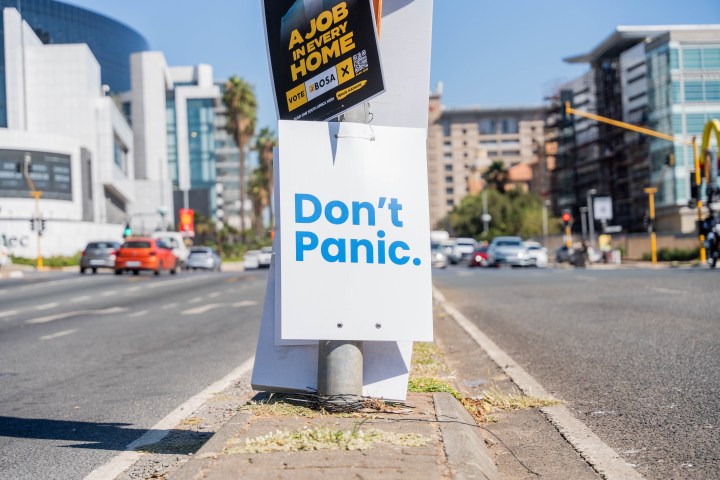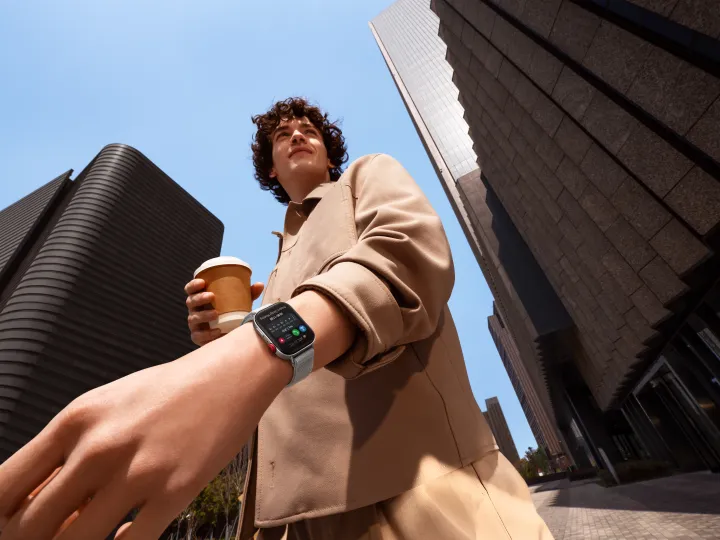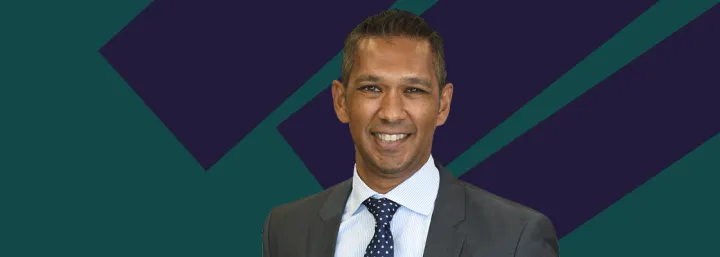MATTERS OF THE ART
An exhibition explores the relationship between art and nature — and what emerges is doubt

The writer explores a new exhibition of abstract artists at Eclectica Contemporary in Cape Town and finds a disconnect between the experience of artworks and the show’s premise.
The problem with abstraction is its open-endedness, which interestingly enough is the same quality that makes it useful. Through the fragmentation of form, disruption of recognisable imagery and a deep analysis of basic principles of art, abstraction can offer an avenue through which to explore complex ideas.
Walking into an exhibition titled In Search of Life, one would be forgiven for expecting a hypothesis on some of life’s most challenging questions — grief, loss, tragedy, joy, hope. But then again, to read any art in terms of absolutes — good, bad, useful, terrible — is perhaps to miss the point completely.

Yasmine Yacoubi, Citrus Sunrise, 2023 Oil on canvas.
Nestled between antique stores, an African artefact market, the oldest art organisation in Cape Town (AVA gallery) and a quaint cafe, Eclectica Contemporary is a gallery I’ve come to associate with figurative realism. Of the 17 artists that make up its stable (as per the gallery website), roughly 10 are working with the figure on canvas.
Although articles have recently surfaced analysing the rise and fall of figurative painting, exhibitions across Cape Town – since the start of this year – suggest that artists and galleries are not yet ready to denounce the form.
There are many examples: Jody Paulsen’s solo exhibition, Open Arms at SMAC; Steven Allwright’s stripe stripe: a miscellany of portraits and potted exotics at 99 Loop; Candice Breitz’s White Face at Goodman; Having but little Gold: Berni Searle at Norval Foundation; Gregory Olympio’s Ligne at blank; Deborah Poynton’s Vertigo at Stevenson; Dominique Cheminais’ Things Done While Dreaming at THK, and When We See Us at Zeitz Mocaa – they all foreground the figure in one way or another; from realist depictions of everyday life to absurdist and surreal images of figures floating in space.
In Search of Life, on view until 7 June, reflects an interesting pivot from the kinds of exhibitions typically staged at Eclectica Contemporary, which tends to favour realism. The exhibition attempts to stage an inquiry into the relationship between art and nature through geometries and abstract patterns — and what emerges is doubt.

Yasmine Yacoubi, Riverbank, 2023 Oil on canvas.
Where there is doubt, to use the language of scholars David Hilderbrand and Douglas Anderson, we call into question what we see. Call it generative doubt or productive doubt. Useful doubt, perhaps.
“Doubt is an experiential signal that there is a need to reconsider and revise our ways of understanding,” suggest Hildebrand and Anderson. That is, to say: is it possible that a combination of shapes, colour and form can stand in for memory, the subconscious, landscapes and history? If so, how do we show this?
The architecture of the Eclectica Contemporary is such that it spatially divides the show into three parts — the front room, where Georgia Lane and Yasmine Yacoubi’s paintings are punctuated with a minimalist sculpture by artist Anthony Lane; a corridor on which Anthony Lane’s colourful wall-based sculptures illuminate the room; and, finally, the back room where Lars Fischedick’s optical illusions are mounted.
The exhibition masterfully showcases a range of techniques — spontaneous sweeping gestures in Yacoubi’s work, arrangements of colour in Lane’s and whirling masses of acrylic and resin in Fischedick’s art. Colours and textures take on varying densities and saturations at different moments.
Writing in the introduction to the book, Abstraction (2013), author Maria Lind posits that although abstraction — as a movement popularised by the first generation of abstract expressionists in the late ’40s to mid-1950s who sought to reject traditional and rational artmaking practices — can easily seem an obsolete or redundant artistic strategy, there are a number of reasons to return to it.
Lind notes: “As an artistic and intellectual practice, with multiple expressions beyond the visual arts, one of abstraction’s key characteristics is the capacity for self-reflection.”

Lars Fischedick, Folded, 2023 Acrylic on carved wood.
I take this to mean that we come to it not only to understand the world around us but ultimately to find ourselves. In this sense, abstraction is unrestricted and open. In the work of Lane, abstraction finds expression as a balance between line and harmonious colour.
In hue, her paintings Inner Soul, Philosophy B and Philosophy C are reminiscent of the Swedish abstract modernist Hilma AF Klint, who used warm and delicate oranges, reds and browns in her paintings and who understood colour as language, able to communicate ideas, thoughts and feelings.
Closer to home, the paintings recall the works of David Koloane whose compositional style reflected near abstract renderings of the Joburg skyline — vivid and glowing rectangles and circles that stand in for buildings and traffic lights.
The artist’s background in graphic design is reflected in her oeuvre through her understanding of how shape, colour, space, form, line, value and texture can be used to convey mood.
Lane’s pulsating and iterative grid works, Metro Pulse and Night Noise, made in 2016, feel less successful. In these paintings, lines stumble over each other and paint is layered densely with tiny squares dotted around the canvas. They lack the sensuality found in the Philosophy works.

Lars Fischedick, Red Door, 2023 Acrylic and resin on Birch plywood.
Yacoubi’s work reflects an immediacy of expression. There is an impression of spontaneity. Undulating landscapes – skies, hills and oceans – could also be read as beautiful yet random patches of colour.
Lane offers an interesting contradiction within his practice. His monochromatic palette of aluminium sculptures sits alongside colourful strips made with wood, paint and ceramic coating. Read together, the works reveal the expressive and imaginative possibilities of geometric abstraction.
Fischedick’s wall-based works are characterised by a warping effect, pulling the viewer’s gaze towards a centre described by the artist as an exploration of “the space between optical illusion and reality”.
My favourite is a work titled Black Star, made with acrylic and resin on birch plywood. The work consists of black straight lines drawn from the edges of the wood and moving towards a glistening vortex. It brings to mind black holes and the vastness of our expanding universe.
Each of the works in the exhibition achieves its visual effect through simplified and schematised forms. However, as a curated exhibition, this simplification fails.
If we are to consider curating as a form of knowledge-making which compares, contrasts, complicates and challenges nuanced thoughts and ideas, In Search of Life fails in drawing these connections.
“Geometries and abstract patterns” as an organising principle and premise to the group show is simply insufficient and too flimsy to produce interesting tensions.
In the same chapter noted above, Lind writes: “To this day, abstraction is characterised by the co-existence of ideal and matter, transcendentalism and structuralism – an ambiguity not to be shied away from but instead acknowledged and explored.”

Georgia Lane, Metro Pulse IV, 2016 Mixed Media on canvas.
Ambiguity is good, but its presentation needs to be executed with care, which is something I struggled to find in this exhibition.
In Search of Life is visually expansive but conceptually lacking. There is a disconnect between the experience of artworks and the claims made, through the press release, on their behalf.
The poetic title is ambiguous enough to allow for any constellation of ideas and threads, which in this show have not been distinctly articulated beyond the connection between nature and art as seeking to “find ways to integrate art and nature in a more harmonious way.”
At times, the artworks feel as though they have been tossed together, while the relationship between art and nature is not sufficiently explored in a convincing manner. DM
This text was produced during an independent journalism development project by African Arts Content focused on The Church Street precinct in Cape Town.
In Search of Life shows at Eclectica Contemporary in Cape Town until early June.




















Comments - Please login in order to comment.